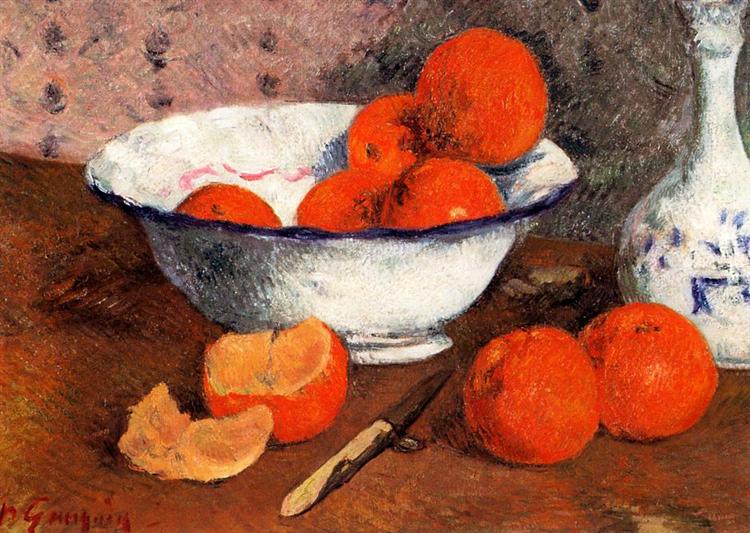Description
Paul Gauguin's Still Life with Oranges, created in 1881, can be seen as a manifestation of his aesthetic search for a visual language that would fuse reality with subjective emotion. This painting, although part of the still life tradition, is distinguished by its strong use of color, its formal simplification and its complex composition. In the context of Impressionism, which marked Gauguin's time, this work begins to delve into a style that anticipates the symbolism and expressive use of color that the artist would develop in his later periods.
In creating this still life, Gauguin presents a group of deliberately arranged oranges in a vibrant hue, which stands out powerfully against the relatively duller background of the canvas. The artist’s work with light and shadow allows the oranges to appear almost luminescent, a passion that reflects his search for a visual experience that transcends mere representation. This use of color becomes a means of arousing emotions in the viewer. The oranges, with their shades of yellow and orange, take on an almost symbolic character, evoking vivacity, warmth, and energy.
The arrangement of the oranges, together with a ceramic plate that holds them, brings a sense of balance to the composition, where the organic shapes are gently contrasted by the geometry of the plate. The way Gauguin spreads the oranges across the canvas may also suggest a connection with the earth and everyday life, in a subtle homage to the nature that surrounds humans, a recurring theme in his work. However, the lack of background details or narrative elements in this work reinforces its introspective nature, focusing solely on the object and its intrinsic meaning.
The painting is also a testament to Gauguin's evolution as an artist. At this point in his career, he was picking up on the influence of the Old Masters and their application of colour and light. The still life, though traditional in its manner of representation, is challenged here by the way Gauguin approaches objects from a more emotive perspective, something that would later become central to the modernity of art. His later rejection of the norms of Impressionism would lead him to a search for an artistic language that embraced symbolisation, as seen in his works later in his life, especially during his time in Tahiti.
Still Life with Oranges can be seen as a bridge between the traditions of the past and a new form of aesthetic perception, paving the way for the visual revolution that Gauguin and other contemporaries would initiate. In its seemingly simple approach, this work invites a deeper contemplation of nature, existence, and the act of creating art itself. Through his masterful technique, Gauguin not only captures the essence of oranges, but also invites us to explore the emotions they evoke, leaving an indelible mark on the development of modern art.
KUADROS ©, a famous painting on your wall.
Hand-made oil painting reproductions, with the quality of professional artists and the distinctive seal of KUADROS ©.
Painting reproduction service with satisfaction guarantee. If you are not completely satisfied with the replica of your painting, we will refund 100% of your money.

